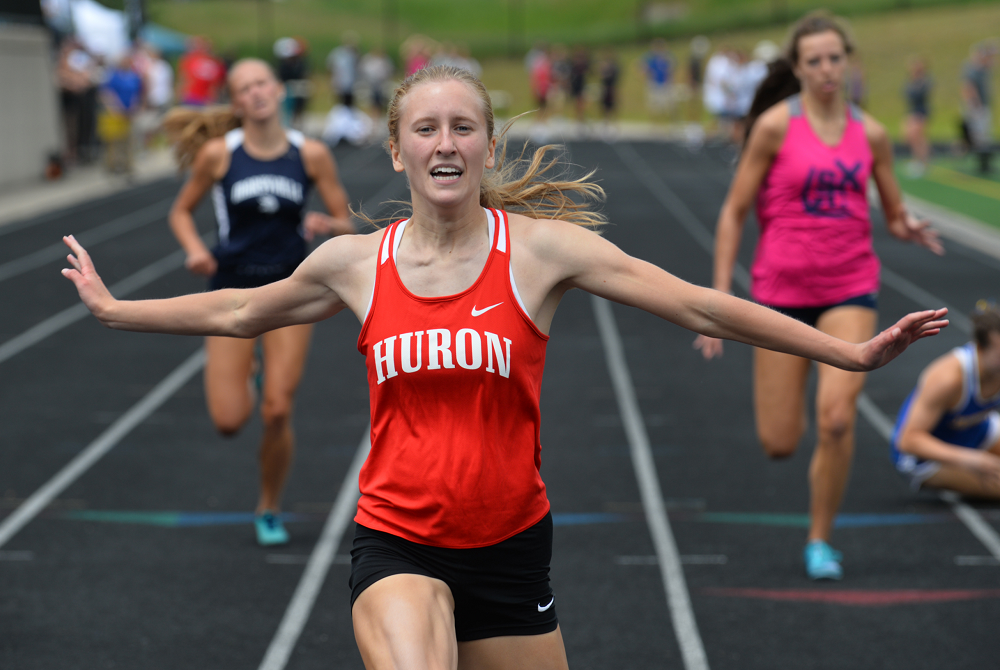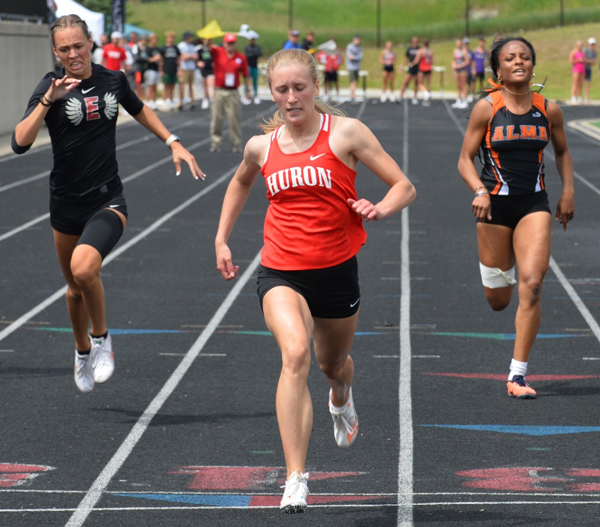
Seniors Cap Record-Setting Careers
By
Tom Kendra
Special for MHSAA.com
June 1, 2013
KENTWOOD – There was no mistaking the marquee event at Saturday’s Lower Peninsula Division 1 Girls Track and Field Final.
With three of the top girls distance runners in the entire country competing, the 1,600-meter final had the undivided attention of a huge throng at windy, but sunny, East Kentwood High School.
Hannah Meier of Grosse Pointe South ran a Finals record time of 4:39.23, outdueling her identical twin sister, Haley Meier (4:42.43), and Erin Finn of West Bloomfield (4:45.37), in a race that was a three-way dead heat with one lap to go.
“I saw them coming up on me with 400 meters to go, and I knew I had to pick it up even a little more,” said Hannah Meier, who will run next year at Duke University, along with her sister. “They pushed me and I finally broke 4:40. I’ve been wanting to break that for a long time now.”
The winning time was announced as the sixth-fastest 1,600 meters ever run by a high school girl in the United States.
The epic victory in the 1,600 was one of her four firsts on Saturday for Meier, which powered Grosse Pointe South and Coach Steve Zaranek to their third-consecutive team championship. Meier also won the 800 meters and ran legs on South’s winning 3,200-meter and 1,600-meter relay teams.
The Blue Devils won with 76 points, followed by Saline with 55, host East Kentwood (47), Rochester Adams (42) and Macomb Dakota (32).
 Saline posted its best-ever Finals finish behind junior Quenee Dale, who won the 100-meter hurdles and also ran a leg on the Hornets’ winning 400-meter relay team.
Saline posted its best-ever Finals finish behind junior Quenee Dale, who won the 100-meter hurdles and also ran a leg on the Hornets’ winning 400-meter relay team.
The final showdown between the Meier twins and Finn, who have dominated Michigan girls track and cross country since bursting onto the scene in the fall of 2009, was certainly the main storyline of Saturday’s Division 1 meet. But while fans were saying goodbye to those three distance legends, they got to know a new sprinting sensation.
Sekayi Bracey, a 15-year-old freshman, almost single-handedly delivered East Kentwood its third-place finish by winning the 100 meters (12.18), 200 meters (24.82) and placing third in the long jump (18 feet, 5.25 inches).
“I was very confident coming in, and I just tried to visualize each race in my head,” said Bracey just moments after winning her final race of the day, the 200 meters, on her home track. “I feel tired right now, but it was worth it.”
Bracey certainly didn’t run away from the field, having to hold off major challenges from second place Dominique Funchess of Detroit Renaissance in the 100 and Anna Jefferson of Oak Park in the 200.
The third-place Falcons also received an individual first place from senior Mariah Davis in the shot put.
 Finn continued her dominance of the longer-distance races by putting on a show in her final high school race, the 3,200 meters. Finn, who will run next year at Michigan, won the race by a whopping 34 seconds – setting an all-division Finals record with a time of 10:08.23.
Finn continued her dominance of the longer-distance races by putting on a show in her final high school race, the 3,200 meters. Finn, who will run next year at Michigan, won the race by a whopping 34 seconds – setting an all-division Finals record with a time of 10:08.23.
Finn acknowledged afterward that she was hoping to go sub-10 minutes.
“I went out there with the goal of the 10-minute barrier,” said Finn. “But that’s OK. I set really high goals and try to get close to them.”
Cierra Pryor of Jackson broke her own meet record from a year ago, winning the long jump with a leap of 19-0.5, a half-inch better than the year before.
The Meiers closed out the meet and their storied prep careers in fitting style, powering the Blue Devils to victory in the 1,600-meter relay.
“The most important thing for us today was to win another team state championship for South,” said Haley Meier. “I didn’t feel that great today, but I had to give it all I had for my team. This is a great way to go out.”
Earlier in the day, the Meiers opened the running portion of Saturday’s finals by each running a leg on the winning 3,200-meter relay team in 9:01.98. The other members on that winning team were Ersula Farrow and Christina Firl.
That impressive time was still 13 seconds slower than South’s 2012 winning time of 8:48.29, which is a National Federation of State High School Associations record. That team featured the Meier twins, Farrow and Kelsie Schwartz.
Winning the two sprint relays were Saline (400-meter relay) and Detroit Renaissance (800-meter relay).
Other individual champions were Jae’vyn Wortham of Harrison Township L’Anse Creuse (discus), Kerri McMahon of Novi (high jump), Jane McCurry of Plymouth (pole vault), Anna Jefferson of Oak Park (400 meters) and Breanna Luba of Southgate Anderson (300-meter hurdles).
PHOTOS: (Top) Hurdlers leap in stride Saturday at East Kentwood. (Middle) The Grosse Pointe South team poses on the medal stand after clinching the LP Division 1 championship. (Below) West Bloomfield's Erin Finn finished her high school career with an all-Finals record in the 3,200. (Photos by John Brabbs. Click to see more photo coverage from RunMichigan.com.)

Multi-Sprint Champ Racing to Finish Huron Career Ahead of the Rest Again
By
Keith Dunlap
Special for MHSAA.com
May 25, 2023
NEW BOSTON – If there was one thing Elizabeth Anderson took pride in elementary school, it was simply showing that she could outrun everyone in sight.
 In fact, Anderson has an explanation for all the success she had in those playground races.
In fact, Anderson has an explanation for all the success she had in those playground races.
“Dominance when you are in elementary school,” Anderson quipped. “I don’t think I ever had a nickname. I just think everyone knew I was fast.”
Years later, pretty much everyone who follows track & field in the state of Michigan can attest to that.
A senior for New Boston Huron, Anderson has been faster than most other competitors in the state during her three-year high school career (with her freshman season in 2020 canceled due to COVID-19).
Last year, Anderson won titles at the Lower Peninsula Division 2 Finals in the 200-meter (25.07) and 400-meter (56.28) dashes, and was runner-up in the 100-meter dash (12.23).
Often, top sprinters focus on one or two of those three races. But Anderson is certainly a different breed of sprinter because she does all three.
In fact, she holds school records in all three of those events, and if all that weren’t enough, Anderson is a part of all three sprint relay teams.
“It is hard to give her events off,” said New Boston Huron head girls track coach Danielle Lobato.
Despite the different styles the 100, 200 and 400-meter dashes present, Anderson said there usually isn’t much adjusting when she goes from one of those races to another.
 The strategy is simply, “Let’s beat the other girls to the finish line.”
The strategy is simply, “Let’s beat the other girls to the finish line.”
“I don’t really go into each race changing up how I would run,” she said.
While enjoying and succeeding in all three races, Anderson said she actually does have a favorite among them.
“I would say the 400 is probably my favorite,” she said. “Even though it hurts, it’s satisfying to see how much you can get your time down in the 400 compared to any other race.”
Anderson said she started running track in sixth grade, but really got serious about it during the summer after her sophomore season, when she was invited to run for a local club.
Eventually, that led to her competing over the winter in indoor events.
She lived and breathed track so much that last fall, she decided to not run cross country so she could focus on a weightlifting regimen aimed at developing more leg strength.
“Once I started doing summer track, I realized I wanted to be doing this all the time,” she said.
Lobato said oftentimes in practice, Anderson is a de facto coach, given there is no better person she can think of for the younger runners on the team to learn from.
“I can’t always demonstrate these things I’m trying to teach,” she said. “You get to see it in real life (from Anderson), not in a YouTube video.”
After winning the 100, 200 and 400-meter dashes at her Regional meet last week, Anderson has her sights set on achieving the same trifecta of titles at next Saturday’s Finals in Grand Rapids.
Anderson has signed to run track at Michigan State, but has been plenty motivated to keep producing this spring in her final high school season.
“I’m really looking to defend my titles,” she said. “That is what is really motivating me to keep going. I want to keep in shape for the college season. I don’t want to lose any of the progress I have made. Ultimately, I just love running track.”
And since elementary school, Anderson has loved — and succeeded in — outrunning everyone else to the finish line.
“We knew we were getting something special,” Lobato said of when Anderson arrived in high school. “But you never expect this. All that she has accomplished is amazing.”
 Keith Dunlap has served in Detroit-area sports media for more than two decades, including as a sportswriter at the Oakland Press from 2001-16 primarily covering high school sports but also college and professional teams. His bylines also have appeared in USA Today, the Washington Post, the Detroit Free Press, the Houston Chronicle and the Boston Globe. He served as the administrator for the Oakland Activities Association’s website from 2017-2020. Contact him at [email protected] with story ideas for Oakland, Macomb and Wayne counties
Keith Dunlap has served in Detroit-area sports media for more than two decades, including as a sportswriter at the Oakland Press from 2001-16 primarily covering high school sports but also college and professional teams. His bylines also have appeared in USA Today, the Washington Post, the Detroit Free Press, the Houston Chronicle and the Boston Globe. He served as the administrator for the Oakland Activities Association’s website from 2017-2020. Contact him at [email protected] with story ideas for Oakland, Macomb and Wayne counties
PHOTOS (Top) New Boston Huron's Elizabeth Anderson clears the finish line during last season's LPD2 400 race. (Middle) Anderson, middle, outpaces the field to also win the 200. (Click for more from RunMichigan.com.)

